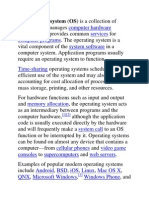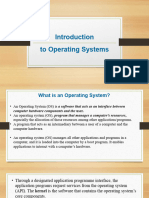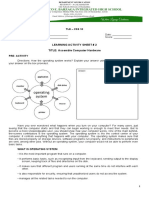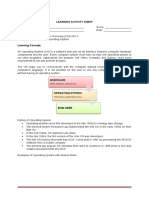0% found this document useful (0 votes)
56 views2 pagesUnderstanding Operating Systems
An operating system manages computer hardware resources and provides common services for programs to function. It acts as an intermediary between programs and hardware for input/output and memory allocation. Popular modern operating systems include Android, BSD, iOS, GNU/Linux, OS X, QNX, Microsoft Windows, Windows Phone, and IBM z/OS, with all except Windows and z/OS sharing roots in UNIX.
Uploaded by
NurulWardinaCopyright
© Attribution Non-Commercial (BY-NC)
We take content rights seriously. If you suspect this is your content, claim it here.
Available Formats
Download as DOCX, PDF, TXT or read online on Scribd
0% found this document useful (0 votes)
56 views2 pagesUnderstanding Operating Systems
An operating system manages computer hardware resources and provides common services for programs to function. It acts as an intermediary between programs and hardware for input/output and memory allocation. Popular modern operating systems include Android, BSD, iOS, GNU/Linux, OS X, QNX, Microsoft Windows, Windows Phone, and IBM z/OS, with all except Windows and z/OS sharing roots in UNIX.
Uploaded by
NurulWardinaCopyright
© Attribution Non-Commercial (BY-NC)
We take content rights seriously. If you suspect this is your content, claim it here.
Available Formats
Download as DOCX, PDF, TXT or read online on Scribd
/ 2
























































